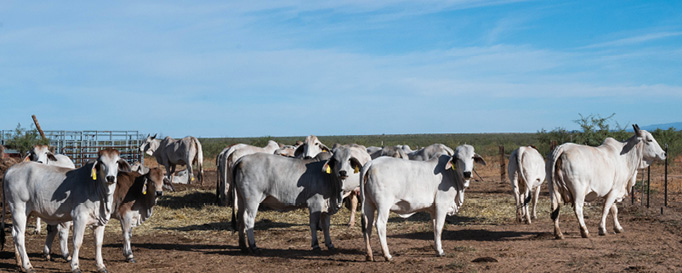A Practical Guide for New Mexico Feeder Cattle Growers
Guide Z-133
Pilja Vitale, Don Martinez, Bonnie Hopkins Byers, Jeffrey Vitale, Eduardo Medina, Nicholas Lowery
College of Agricultural, Consumer and Environmental Sciences, New Mexico State University
Authors: Respectively, Extension Economist, Department of Extension Economics (EE), NMSU; Extension Agricultural Agent and County Program Director, Rio Arriba County Cooperative Extension Office, NMSU; Extension Agricultural Agent and County Program Director, San Juan Cooperative County Extension Office, NMSU; Associate Professor, Agricultural Economics, Oklahoma State University; Extension Specialist and Program Manager, Extension Economics, NMSU; and Crop Insurance Consultant, American AgCredit. (Print-friendly PDF).

Photo by Josh Bachman. NMSU, 2021.
Most New Mexico ranches have cow-calf operations, making their income heavily dependent on the value of weaned feeder calves. Feeder calf prices can swing sharply due to drought, rising feed costs, or national market shifts, wreaking havoc on the cattle basis price. Federal insurance programs like Livestock Risk Protection (LRP) have been available since 2002, but many livestock producers may not understand the options or whether they’re worth it. Approximately 15% of New Mexico ranches currently utilize LRP to protect themselves against price drops, leaving the remaining 85% self-insured and are vulnerable to market risk.7
LRP offers a straightforward, flexible way to protect against price declines, without requiring ranchers to sell weaned calves on a certain date or at a specific location.
This guide walks through how LRP works, who qualifies, what coverage options exist, and how to decide if it fits your operation. It also includes practical examples and tips to help New Mexico ranchers make confident, informed decisions.
1. What is LRP insurance?
Livestock Risk Protection (LRP) is a federally subsidized insurance program designed to help cattle producers guard against unexpected price declines. For cow-calf and stocker operations in New Mexico—where drought, volatile markets, and limited access to sale barns or auctions are common—LRP offers a flexible tool to manage price risk. It allows the producer to selection of a coverage price for calves based on national market forecasts published by the USDA. If the market price, based on USDA’s national cash index, falls below the selected level at the end of the coverage period, you receive a payment to offset the loss it made.8
The LRP doesn’t cover drought-related losses, production costs, or guarantee a local sale price, but can help stabilize income when cattle prices drop. Importantly, LRP does not restrict when or where you sell your livestock, you remain free to choose the timing and location of your sale.
2. Why It Matters in New Mexico
Ranchers in New Mexico deal with challenges that make price protection especially important. Drought, high feed costs, and small herd sizes make it difficult to recover from bad market years. Many ranches depend on selling fall-weaned calves, sometimes after growing them out on grass or native rangeland. Others graze cattle on public land and have to work around half a year of grazing seasons. Most ranchers in New Mexico don’t use complex price tools. LRP provides a simple, flexible way to guard against price drops without changing how or the cattle are sold.
3. How Does LRP work?
In New Mexico, most ranchers use LRP to cover feeder cattle, that includes weaned calves under 600 pounds, as well as stocker or yearling cattle between 600 and 1,000 pounds. These animals fall under the USDA’s “feeder cattle” category for LRP. Since many ranchers in the state sell calves and yearlings between September and November, LRP aligns well with the typical fall marketing season. LRP provides livestock producers protection if market prices fall, where they may have not had any type of risk mitigation in place prior.
3.1 What choices does a rancher make?
When you sign up for LRP, you make a few simple choices to match your cattle and marketing plan.3
First, the producers select the type of cattle. Most ranchers in New Mexico use LRP for feeder cattle—this includes weaned calves and stockers—and not finished cattle. At this time, the producer selects “steers” or “heifers” and the number of cattle to be insured. This can be from one head to up to 12,000 head per endorsement, 25,000 head per crop year.
Second, producers choose the expected weight (a projected average sale weight) at the time of sale. Two weight categories are available for selection: 100 to 599 pounds known as “weight 1”, and 600 to 1,000 pounds known as “weight 2”.
Third, ranchers select the endorsement length that best fits the time of year that they plan to sell their cattle. The coverage periods range from 13 to 52 weeks, with specific options including 13, 17, 21, 26, 30, 34, 39, 43, 47, and 52 weeks.
Finally, the ranchers select a coverage level/coverage price, often between 70% and 100% of the expected ending value of forecasted market price at the end of the coverage period. The LRP program is a daily priced crop insurance program, which may not be offered at all on certain days, most notably on federal holidays.2
3.2 When does LRP pay the rancher (benefit of LRP)?
LRP feeder cattle coverage pays if the actual ending value (based on USDA’s national cash index) is lower than the selected coverage price at the end of the coverage period. A producer will receive payment on the difference between these two prices, minus the cost of the coverage.
Producers will have to provide livestock records if they have a loss. These records will be used to verify ownership, date of sale, and the head count of cattle. Additionally, they are used to verify that policy guidelines for their LRP coverage were met, in understanding that the indemnity is based on the market index and not unique producer sales.
According to the USDA’s Risk Management Agency (RMA), LRP tends to perform best when ranchers choose higher coverage levels and longer coverage periods. A higher coverage level establishes a stronger price floor, resulting in larger payouts if market prices fall. Though premiums may be higher, the protection is greater. Longer coverage periods often lower premiums per hundredweight and offer more time to benefit from a price decline if it occurs later in the season.
3.3 Example: Chart of LRP mechanics
- Don Ranch selects LRP for 100 head of 600 lbs. calves, expected to sell in late October
- Coverage period: 13 weeks
- Coverage price: $330 per cwt
- Actual ending value in October: $300 per cwt
- Payout Calculation:
(Coverage Price – Actual Ending Value) X Weight(cwt) X head
($330 – $300) X 6.0 cwt X 100 head = $18,000 indemnity
3.4 How much premium does the rancher owe?
LRP premiums vary based on your coverage level, the length of coverage, and current market conditions. USDA helps lower these costs by subsidizing 35% to 55% of the premium; ranchers pay only part of the total, with lower coverage levels receiving higher subsidy rates.
Premiums are billed after coverage ends on the first day of the second month following your endorsement’s end date.
An Example of Premium Calculation
Step 1. Expected ending value: $330.00/cwt (assumed, determined by actual market outcomes, not selected by the rancher).
Step 2. Selected Coverage Level: 95% (rancher’s choice)
Coverage price: $313.50/cwt (calculated as $330 X 0.95)
Step 3. Rate: 1.4% of coverage price varies day to day (set by USDA-RMA): This 1.4% is an example of the premium rate—the cost the producer pays per unit (e.g., per cwt) to insure livestock at the selected coverage price.
Premium per cwt: $4.39(calculated as $313.50 X 0.014)
For current premium rates and details, visit: https://public.rma.usda.gov/livestockreports/main.aspx
Step 4. Weight: 600 lbs. = 6.0 cwt (rancher’s choice)
Premium per head: $26.34($4.39X 6.0)
Step 5. USDA Subsidy: 35% (based on coverage level selected)
Premium per head (rancher pays): $17.12 (calculated as $26.34 *(1- 0.35)
3.5 Who qualifies to participate in LRP insurance?
To sign up for LRP, you need to meet a few basic requirements. You must own or control the cattle when you buy the coverage, and your operation must be in the U.S. or its territories. You also need to be a U.S. citizen or a legal entity, for example, a family partnership or ranching business. Insured livestock must be part of a working, commercial operation—not a hobby herd. You need to have at least a 10% ownership stake in the cattle and you must go through a licensed LRP insurance agent to enroll. Your LRP Crop insurance agent will get an application approved to utilize the LRP program through authorized insurance providers (application has no cost associated with it). Once an application is accepted by RMA, a producer can book coverage on cattle using LRP coverage endorsements. These endorsements must be signed & submitted by 8:25am central time of the following day in order to be accepted / approved.4
3.6 What’s new in 2025? Two key updates for New Mexico ranchers
Two important updates in 2025 expand how LRP can help New Mexico cattle growers6:
- Unborn Calves Eligible: Cow-calf operations can insure calves that are not yet born, as long as the expected birth weight and timing meet USDA guidelines. This allows ranchers to protect calf prices earlier than ever, during the breeding and gestation phase. This will require 3rd party pregnancy check on Heifers to make sure there is a reasonable number of calves insured under the endorsement.
- Drought Hardship Exemption: In counties experiencing severe drought (based on USDA Drought Severity Coverage Index, USDA Drought Monitor), LRP now allows early sale of insured cattle—more than 60 days before the policy end date—without losing eligibility for payment. This gives growers more flexibility if they need to sell early due to feed shortages or water stress.5
These changes make LRP more adaptable to New Mexico’s dry climate and the realities of ranching under increasing uncertainty.
4. Steps to Enroll LRP: How to Enroll in LRP (Quick Checklist)
□ Contact a licensed LRP agent□ Fill out a one-time application (with basic operation information)
□ Choose what to insure: cattle type, weight range, number of head, coverage level and endorsement length (13-52 weeks)
□ Review daily LRP rates and lock in a Specific Coverage Endorsement (SCE)
□ Premium is billed after coverage ends-on the first day of the second month following the end date
□ Wait for USDA to publish the Actual Ending Value
□ Receive an indemnity if the Actual Ending Value is below your Coverage Price
5. Is LRP Right for Your Ranch? Checklist
□ Do you rely on selling weaned calves or yearlings for a major part of your income?
□ Are you concerned about market volatility—price swings caused by drought, feed costs, or national trends?
□ Do you want to lock in a price floor but still choose your own sale date and buyer?
□ Do you sell calves between April and October, when prices can shift fast?
□ Would a large price drop in the next few months hurt your cash flow or ranch plans?
□ Do you have fewer than 25,000 head per year (the annual LRP limit)?
□ Would you benefit from affordable protection, knowing USDA covers 35–55% of the premium?
□ Are you willing to accept a premium billed after coverage ends in exchange for income protection if prices fall?
If you checked several boxes, LRP may be a useful tool for your operation. Talk to a local licensed insurance agent or Extension specialist to explore your options and see real premium quotes.
6. LRP Resources
For more information or help getting started with LRP:
- Contact a licensed LRP insurance agent. You can find one through the USDA Risk Management Agency’s (RMA) Agent Locator tool: https://www.rma.usda.gov/tools-reports/agent-locator
- Talk to your local Cooperative Extension office. They can explain how LRP works and help you compare options.
- Explore current LRP prices and coverage terms at: https://public.rma.usda.gov/livestockreports/main.aspx, Premium rates and ending values are updated daily by USDA.
References
- Burdine, K. (2024). Livestock Risk Protection Insurance (LRP): Applications and Challenges [Presentation materials]. Conference of Outlook at Oklahoma State University
- Griffith, A. P. (2021). Livestock Risk Protection Insurance (LRP): How It Works for Feeder Cattle [Publication W312]. University of Tennessee Extension.https://utia.tennessee.edu/publications/wp-content/uploads/sites/269/2023/10/W312.pdf
- Producers Agriculture Insurance Company (ProAG). (2025a). Livestock Risk Protection Feeder Cattle. https://www.proag.com/campaign-livestock/
- Producers Agriculture Insurance Company (ProAG). (2025b). Livestock Risk Protection Specific Coverage Endorsement Form. https://www.proag.com/wp-content/uploads/2024/04/LRP-SCE-Livestock-Risk-Protection-LRP-Specific-Coverage-Endorsement-2024-04.pdf?v=1.0.0
- USDA, U.S. (2025). Drought Monitor, the Drought Severity and Coverage Index (DSCI). https://droughtmonitor.unl.edu/data/docs/DSCI_fact_sheet.pdf
- USDA Risk Management Agency. (2025, April). Summary of Changes for the Livestock Risk Protection Insurance Policy Specific Coverage Endorsement for Feeder Cattle. https://www.rma.usda.gov/sites/default/files/2025-04/Livestock%20Risk%20Protection%20Feeder%20Cattle%20Endorsement%2026-LRP-Feeder%20Cattle.pdf
- USDA Risk Management Agency. (2023, February). A Risk Management Agency State Profile: New Mexico Crop Insurance, 2022 Crop Year. https://www.rma.usda.gov/sites/default/files/state-profiles/2022-New-Mexico-State-Profile.pdf
- USDA Risk Management Agency. (2005). Livestock Risk Protection Feeder Cattle. https://www.rma.usda.gov/sites/default/files/2024-02/LRP-Feeder-Cattle-Fact-Sheet.pdf
Pilja Vitale is an extension economist in the Cooperative Extension Service at New Mexico State University. She received her B.S. in Agricultural Economics from Seoul National University, an M.S. in Agricultural Economics from Texas A&M University, and a Ph.D. in Agricultural Economics from Oklahoma State University. Vitale worked with vegetable farmers in Oklahoma for about 20 years and her interest areas are crop and livestock budgets and production economics.
To find more resources for your business, home, or family, visit the College of Agricultural, Consumer and Environmental Sciences on the World Wide Web at pubs.nmsu.edu.
Contents of publications may be freely reproduced, with an appropriate citation, for educational purposes. All other rights reserved. For permission to use publications for other purposes, contact pubs@nmsu.edu or the authors listed on the publication. New Mexico State University is an equal opportunity employer and educator. NMSU and the U.S. Department of Agriculture cooperating.
August 2025. Las Cruces, NM.



